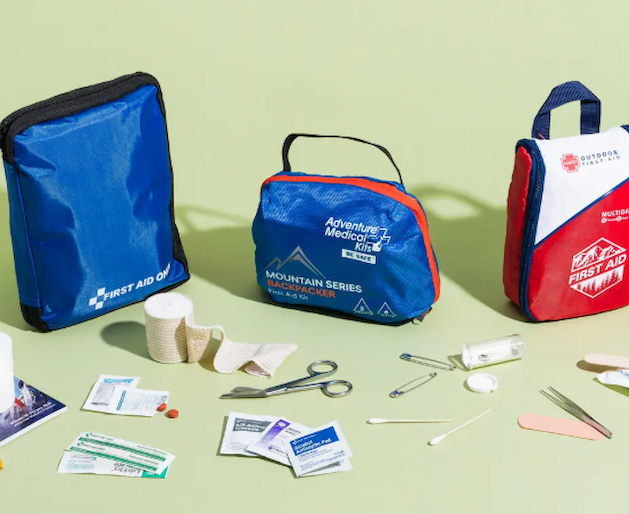Being in the great outdoors is a blast. Hiking through the woods, sleeping under the stars near a tranquil lake, or heading out on a hunting trip are all examples of outdoor fun. Outdoor activities do have a downside, however, and carrying the right safety equipment can make all the difference if things don’t go well. Having a few essentials on hand ensures that you’re prepared for your own crises and in the event you do encounter someone else in need of assistance.
First Aid Kit

All outdoor users must be prepared with a first aid kit. It doesn’t have to be very advanced, but it must contain sufficient material to treat cuts, blisters, scrapes and small burns. Adhesive bandages, antiseptic wipes, painkillers, tweezers and adhesive tape are all essentials that you will need to stock.
A good first aid kit can mean the difference between continuing to enjoy the rest of your holiday in comfort and a premature return home. It can prevent minor issues from worsening into something more serious, such as a blister developing into an infected wound. Pre-packaged kits are readily available and perfect for beginners.
Bleeding Kit
A standard first aid kit is enough for everyday cuts and scrapes, but a bleeding kit is reserved for life-and-death emergencies where major bleeding needs to be stopped as fast as possible. Bleeding kits are compact, lightweight and lifesavers, literally if medical help is far, far away.
What is in a bleed kit? At the center of the most reliable stop the bleed kits is the C-A-T® Tourniquet, a tool that can be used to immediately stop major bleeding from an arm or leg. It is easy to use even in stressful situations, and has been effectively tested in emergencies. It is usually accompanied by a 6-inch NAR Responder ETD (Emergency Trauma Dressing). This is basically a heavy-duty dressing that can be placed directly on a wound to stop bleeding.
The kit also normally comes with two packs of NAR Responder Compressed Gauze. While they are small and light, they expand so that you can pack injuries and add additional pressure. Two pairs of nitrile gloves are included so that you can keep things protected and clean when treating a person, something that is particularly important with blood involved.
Other useful items that are usually included in bleeding control kits are trauma shears to cut through clothing, a survival blanket to warm up a casualty and avoid shock, and even a permanent marker, which can come in small sizes. The marker may be a surprise, but it comes in handy when noting the time a tourniquet was applied, something that is crucial to record for medical personnel later on.
A Just-in-Time instruction card provides brief, step-by-step instructions for running the equipment, which is very handy if you are in a hurry. The stop the bleed kits equipment is usually stored in an extremely visible, bright red nylon bag so you can quickly locate it in your pack when you need to use it in a rush. A few have the added feature of a PVC bleeding control patch on the exterior to allow easy identification. Having all of this gear stored in an orderly bag allows you to respond immediately.
Sun Protection
Long days outdoors translate to day-long sun exposure, which is dangerous unless you’re prepared. Sun protection is more than sunscreen, though that must always be applied consistently. Wide hats, UV-blocking sunglasses, and lightweight long-sleeved clothing can all provide layers of protection against damaging rays. Even on cloudy days, ultraviolet light causes sunburn or long-term damage. Keeping a tube of sunscreen in your daypack and reapplying it frequently is simple and valuable protection.
Insect Repellent
Insects are part of being outside that can’t be helped, but bites and stings are more than just a nuisance. Mosquitoes and ticks in certain areas also transmit disease, so repellent is essential. DEET, picaridin spray or lotion will handle most situations, and permethrin-treated clothing can provide protection even longer.
Maps
Despite GPS devices and cell phones, there’s no substitute for a paper map when you’re in the backcountry. Batteries die, signals are lost and technology fails. A topographic map gives you a reliable stand-in, showing trails, landforms and water sources. Knowing how to read a map and merge it with a compass is a valuable skill for anyone who is going out into nature. Not only does having that information make you safer, but it also allows you to go out more confidently without relying solely on electronic devices.
Whistle

It is a small whistle, but a very effective emergency signaling tool to carry. The voice can only travel so far, but the loud and clear ‘yip-yip-yip’ of a whistle will cut through wind, leaves and other background noise. In the event of getting lost or injured, three short blasts are the recognized distress signal.
In Summary
Time in the outdoors is enjoyable, liberating, and exhilarating, but preparation is key to making sure your trip is safe and enjoyable. Essentials like a first-aid kit, bleed kits, sunscreen, insect repellent, maps and a whistle are simple to pack but provide peace of mind.


